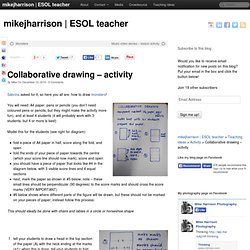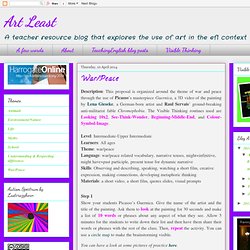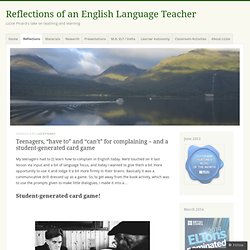

ESL Kids Games. Fortune teller revision activity. This lesson idea can be used with kids* to revise 3 sets of vocabulary, spelling and grammatical structures.

It’s a fun task, they get to make something and then play with it afterwards. Stealth learning! First,get the students to think about the vocabulary you want them to use. A board race is a good idea because then you can check spelling (I told students there were x number of spelling mistakes and asked them to find them all, using their books if necessary) and the vocab remains on the board. Next, model the final product and fortune-telling activity so the students know what they’re aiming for.
Then, give each student a piece of paper and show them how to make the fortune teller. Explain these next parts very carefully so that the students write in the correct place. Then they choose another 8 items of vocabulary (from a different set) to write on the inside: Lastly, they write 8 sentences using the structure you are revising, and perhaps another vocabulary set, eg. Reported speech. Collaborative drawing – BODY. Sabrina asked for it, so here you all are: how to draw monsters!

You will need: A4 paper, pens or pencils (you don’t need coloured pens or pencils, but they might make the activity more fun), and at least 4 students (it will probably work with 3 students, but 4 or more is best) Model this for the students (see right for diagram): fold a piece of A4 paper in half, score along the fold, and openfold the ends of your piece of paper towards the centre (which your score line should now mark), score and openyou should have a piece of paper that looks like #4 in the diagram below, with 3 visible score lines and 4 equal sectionsnext, mark the paper as shown in #5 below; note – these small lines should be perpendicular (90 degrees) to the score marks and should cross the score marks (VERY IMPORTANT)#6 below shows where different parts of the figure will be drawn, but these should not be marked on your pieces of paper; instead follow this process: Like this: Like Loading...
TOPICS. The Learning Network - The Learning Network Blog - NYTimes.com - NYTimes.com. War/Peace. Ask your students to classify what they can see in the painting in 3 groups: humans/animals/objects.

Then, ask them: What colours do you see? What shapes do you see? Introduce briefly the historical facts behind the painting: in 1937, during the Spanish Civil War, Nazi Germany supported its fascist ally Francisco Franco and bombed Guernica, the ancient capital of the Basque region in northern Spain. The town was utterly devastated by the aerial bombings and served for the Nazis as a blueprint for terror bombings of civilian populations. Picasso created Guernica to show the true horrors of war for innocent civilians. Step 7Show the quotes and let your students guess whether they refer to war or peace.
Step 8 Show them the visual prompts and ask them to identify whether they symbolize war or peace. You can have a look at some extracts from my 6th grade primary students' learning journals here. Organize them in groups and ask them to choose one of the 3 questions:1. Teenagers, “have to” and “can’t” for complaining – and a student-generated card game. My teenagers had to (!)

Learn how to complain in English today. We’d touched on it last lesson via input and a bit of language focus, and today I wanted to give them a bit more opportunity to use it and lodge it a bit more firmly in their brains. Basically it was a communicative drill dressed up as a game. So, to get away from the book activity, which was to use the prompts given to make little dialogues, I made it into a… My students aren’t this old (nor, fortunately, this dour-looking) but they like cards!
Pre-intermediate (but adaptable) None! Each student needs a piece of paper from their notebook (or provided by you) Nigeria kidnap lesson.